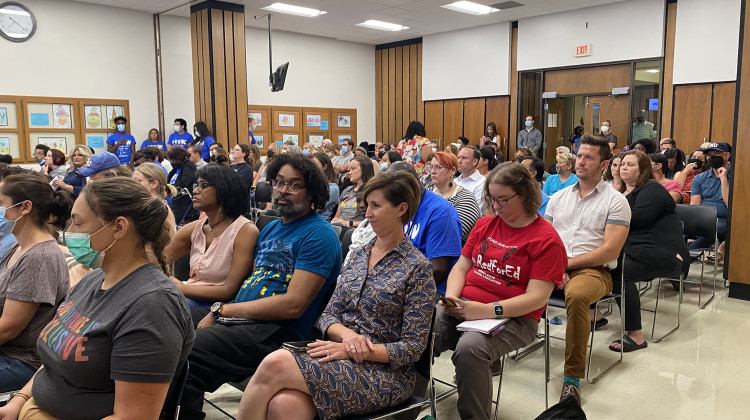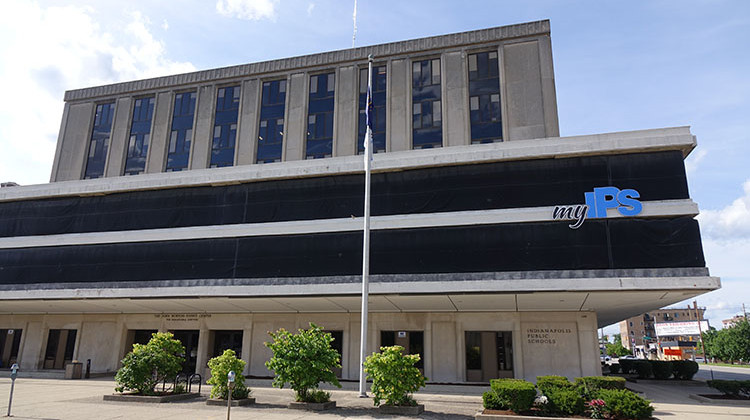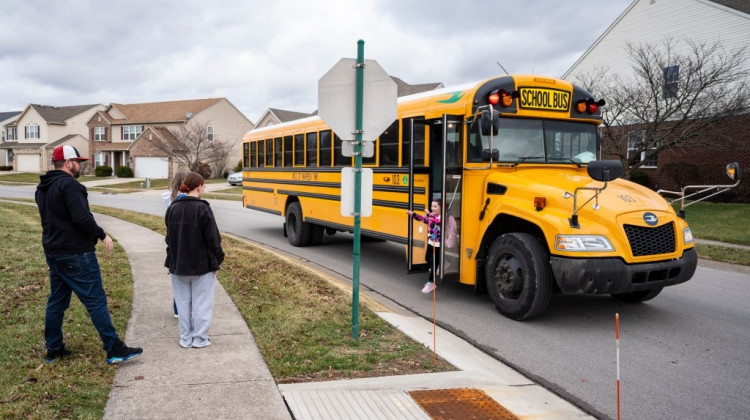
More than 130 people attended a meeting of the Indianapolis Public Schools Board of Commissioners at the district's main office Thursday, Aug. 25, 2022.
Elizabeth Gabriel/WFYIA proposal to restructure the Indianapolis Public Schools district will be released Sept. 13, Superintendent Aleesia Johnson announced to a packed room Thursday.
More than 130 people attended the IPS school board meeting at the district's main office. Every seat in the audience was full, and some had to stand. Families were stepping up to tell the commissioners their concern about what is known so far of the restructure plan.
Earlier this summer Johnson said the formal proposal would potentially lead to five main changes:
- Replicate school models that are proven to increase academic performance for students of color.
- Make all elementary schools K-5, and create 6-8 middle schools.
- Close and merge schools with low student enrollment and poor building conditions.
- Create enrollment zones across the district that include multiple school models.
- Eliminate priority zone enrollment that gives preference to families with homes located within a half-mile radius of a choice school option.
The formal proposal will be released online after Johnson’s state of the district address Sept. 13.
Community and school-based informational meetings about the plan will be held from Sept. 14 – Oct. 17. The commissioners are expected to vote on the plan in November, a month later than previously planned
The draft plan has led to confusion and concern for some district families. This month, 70 people submitted written public comments to the school board, in addition to roughly 40 people speaking in-person this week. Some say they wouldn’t be opposed to redesigning the district but they just want a clearer idea of Johnson’s plan.
The three main concerns mentioned Thursday during public comment to the board were about the district potentially shifting away from the K-8 model, requests to replicate high-performing school models and the lack of transparency about the process.
An end to K-8 schools
Many people said turning K-8 elementary buildings into K-5 schools would take away school choice. Seventh grader Ella at Rousseau McClellan MontessoriSchool 91, which currently uses the K-8 model, said she doesn’t want her school to change because it would be a jarring experience for students who have never attended a middle school before.
“I personally have had a much better experience with being in the same building from first grade when I started at School 91, up until now,” Ella said. “I have such a good experience because I’ve known people in my grade, and the grades ahead of me. And I know the teachers so I’m not as nervous as I would be if I were going to other schools.”
Before the public comment period, two IPS principals spoke in favor of the proposed plan. Adrienne Kuchik is the principal at the K-8 school James Garfield School 31 in the Bates-Hendricks neighborhood.
“IPS is one of very few corporations in the state that still utilizes the K-8 model,” Kuchik said. “While I manage this model daily — and I do enjoy doing it as a former middle school teacher — there are many reasons why this model is outdated. Curriculum is very different, behaviors are very different, expectations are very different among those grade levels.”
Kuchik said the K-8 model prevented certain opportunities like algebra and foreign languages classes at the school because she doesn’t have the funds to pay for it.
Request to replicate schools
At least a dozen people wore matching blue shirts — that read “Grow schools that work for our children” — as a sign of solidarity of parents who want the district to replicate school models, particularly charter schools, that have increased standardized test scores for students of color compared to some district schools. Those parents, such as Shawanda Tyson, are part of the parent advocacy group Stand for Children.
“I want to see IPS grow schools that work for Black and Brown children and close the opportunity gap, and not only because these schools are popular,” Tyson said. “As a group, we want to see you act now. Our babies can’t wait to have school models that are working for them.”
Kristen Phair, a mother of three kids at George Washington Carver School 87, a K-8 building, wants to see the district invest in neighborhood schools. But she thinks that investment should be based on the wants of the community.
“It seems like there isn’t a plan for them other than to close them and let them be taken over by charters — the ones that are under-enrolled or low-performing,” Phair said “What I really want to see is, invest in those neighborhood schools because they’re also built on a community just like my schools built on a community.”
What’s the future of the district?
Many parents spoke about the district’s lack of clarity about the specific details of the plan. School 91 parent Ivy Wright worries how potential school closures will impact the future of communities.
“Closing neighborhood schools results in the loss of a neighborhood organization in places where there are few,” Wright said. “Economically, schools are tied to neighborhood development trajectories and have deep effects on local businesses and real estate. And physically, large, vacant buildings are bad for neighborhoods and might be redeveloped for purposes not in the community’s interest.”
Some parents said they would leave the district if these sweeping changes were approved. Many families asked for more transparency about the plan and more data about the ways potential changes could impact children.
Windi Hornsby lives in Washington Township, but she chooses to send her third and fifth grade daughters to Theodore Potter School 74. She said the lack of information is leading to “frustration, rumors and misinformation.”
“I start again by asking the board to strongly consider the value of transparency from the beginning of processes like these,” Hornsby said. “The information presented tonight needed to be released months ago and questions answered tonight. This model of communication needs to start with the board to trickle down to the schools — many of whom struggle with this.”
The district asked parents this summer to provide feedback to the plan through an online survey. Thursday a spokesperson said the results will be available in the coming days.
Correction: The quote from Kristen Phair was updated to describe some neighborhood schools as "under-enrolled."
Contact WFYI education reporter Elizabeth Gabriel at egabriel@wfyi.org. Follow on Twitter: @_elizabethgabs.
 DONATE
DONATE






 Support WFYI. We can't do it without you.
Support WFYI. We can't do it without you.